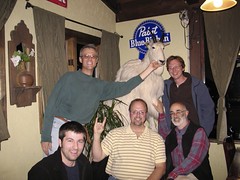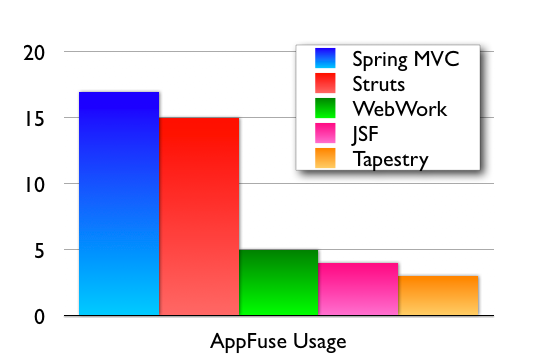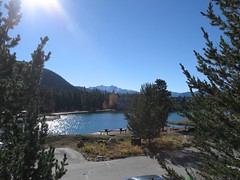The main reason that Geronimo was started was to have a BSD-style licensed Java application server. The other two open-source application servers are JOnAS and JBoss, both of which are LGPL. The advantage of having a BSD/Apache licensed container is that companies can put it into their products, or develop products with it - w/o worrying about licensing issues. Bruce says IBM just validated the goals of Geronimo with their WebSphere Community Edition.
Geronimo's architecture is designed around GBeans - which are services that are pluggable inside of the kernel. To learn more about GBeans, see Jeff Genender's article "Integrate third-party components into Geronimo". The GBean is an IoC container in itself. Bruce is now showing a GBean Descriptor for ActiveMQ. There are only a few main elements in this XML file: multiple <dependency> elements and <gbean> elements. The dependency element refers to a JAR and the idea was borrowed from the Maven project.
Bruce, the poster-boy for Maven 2 only made it 15 minutes before he mentioned Maven. 
For more information about integrating ActiveMQ in Geronimo, see Sing Li's article "Magic with JMS, MDBs, and ActiveMQ in Geronimo".
Deployers vs. Builders: Deployers are J2EE specific, Builders are Geronimo specific. The Geronimo Deployer is JSR-88 compliant and handles both deployment and distribution. Personally, I'm a little disappointed that Geronimo doesn't support hot-deploy out-of-the-box, but I can understand their desire to be spec-compliant first, and developer-friendly 2nd. After all, it is an IBM product. 
Geronimo's deployer is currently a script that you can pass arguments into. There is also a webapp console (developed and donated by Gluecode) that's based on portlets. It uses JetSpeed under the covers and looks to be a pretty slick little webapp. Bruce started up Geronimo and showed us the console UI - it appears Geronimo's default footprint is about 20 MB.
Custom Assemblies: One of the nice things about Geronimo is that it's so configurable. Because of it's architecture, you can easily create custom assemblies. Here's a few examples:
- Tomcat + Derby + Jetspeed + ActiveMQ
- Jetty + Apache DS + ActiveMQ + OpenEJB
- Jetty + JOTM + Derby + OpenEJB
- Tomcat + ActiveMQ + Spring Kernel + ServiceMix
The Geronimo Kernel and GBeans make all of this possible. This is pretty cool IMO, especially with the whole Agile Java EE movement. Bruce thinks this is real future of Geronimo: the stacks that can be created with it. He expects the innovation and ideas in this area will come from the community and what users want.
Geronimo Community: Made up of many different open-source projects: MX4J, ActiveMQ, Tomcat, ActiveCluster, HOWL, JOTM, TranQL, Derby, Jetty, ServiceMix, OpenEJB. Rather than re-creating everything (the ol' NIH syndrome), the Geronimo team has tried to embrace and re-use other open source projects as much as possible. Many of the committers on the aforementioned projects are Geronimo committers or founders.
Bruce's favorite quote: In open source, we come for the code, we stay for the people.
Project Status: Now a top-level Apache project. Has officially passed J2EE 1.4 certification tests. The official 1.0 release date is "when it's done it's done", but the developers are hoping to finish by ApacheCon.
Below are notes I took while attending Tom Bender's talk on Mule at the Colorado Software Summit:
SOA: A collection of services with well-defined interfaces and a shared communication model is called a service-oriented architecture.
ESB: Provides a light weight, loosely coupled, event-driven SAO with a highly distributed universe of naming routing destinations across a multi-protocol message bus.
Four Tenets of SAO (as proposed by Don Box):
- Boundaries are Explicit
- Services are Autonomous
- Services share Schema and Contract, not Class
- Compatibility is based upon Policy
Properties of an ESB: Light Weight, Loosely Coupled, Event-Driven, Transactional, Securable, Distributed Network Topologies, Abstract Endpoints, Intelligent Routing, Message Transformation (inbound/outbound), Multi-Protocol Message Bus.
One of the main differences between application servers and ESBs is appservers are traditionally integrated with a hub-and-spoke architecture. ESBs, on the other hand, use a distributed integration architecture.
Mule - What is it?
Ross Mason is the founder and primary developer of Mule. From its homepage:
Mule is an Enterprise Service Bus (ESB) messaging framework. It is a scalable, highly distributable object broker that can seamlessly handle interactions with services and applications using disparate transport and messaging technologies.
Mule is an event-based architecture. Actions within a Mule network are triggered by either events occurring in Mule or in external systems. It's a light-weight messaging framework that's highly distributable and very pluggable (i.e. for multiple transports and protocols). Mule supports Web Services using Axis or Glue.
A Closer Look at Mule
The basic building block is a "UMO Component". This component is used to wire applications together - it's basically a POJO that can optionally implement interfaces if it wants to hook into lifecycle events. An application communicates with the UMO component through a channel (i.e. TCP/IP or JMS). This channel talks to a message receiver that works with a connector that's backed by a transformer and formats it for the UMO component (whoa, that's a mouthful - and that's only inbound!). When going to the receiving application, the process starts from the UMO component, goes though the outbound router - and plows through the whole transformer » connector » message dispatch » channel » application process again. Here's a diagram of this process that I found on Mule's website:

Mule supports many different endpoints: POP3/SMTP, JMS Topic or Queue, HTTP, File, VM (w/in the JVM), SOAP, RMI and EJB. Each of these have their own URI prefix.
I tuned out for the rest of Tom's talk (sorry Tom). The whole ESB topic is pretty dry IMO, but Tom seemed to do a good job of keeping the audience interested.
The best part about the Colorado Software Summit has been the fact that I can travel home at night. Keystone is beautiful, the conference is well organized - but hopping in my car and sleeping in my own bed last night was awesome. This morning, I'll be heading to breakfast with the family, taking Abbie to school and then driving back up for some dynamite sessions this afternoon.
Tom Bender is speaking at 1:00 on "Mule - A Detailed Look at an Enterprise Service Bus", followed by Bruce's "Apache Geronimo Architecture and Community". I'm staying with both of these guys in a nice condo on the lake (across from the conference center) so it should be fun to hear them speak. I'll do my best to blog both sessions.
Here's a good quote from John Soyring's keynote on Monday:
... Geronimo is a subset of Websphere ...
I especially enjoyed this b/c I was sitting next to Bruce Snyder, one of the founders of Geronimo.
This quote seems to have been backed up yesterday with IBM's release of WebSphere Community Edition.












